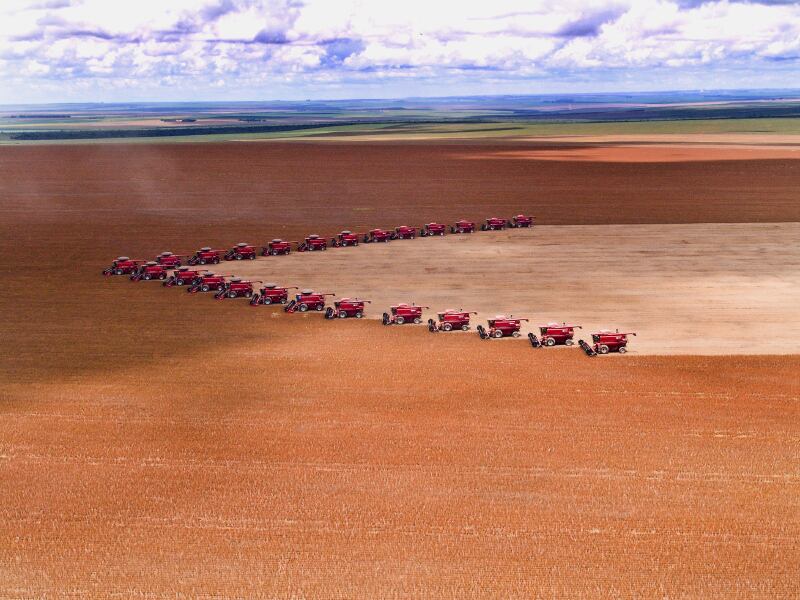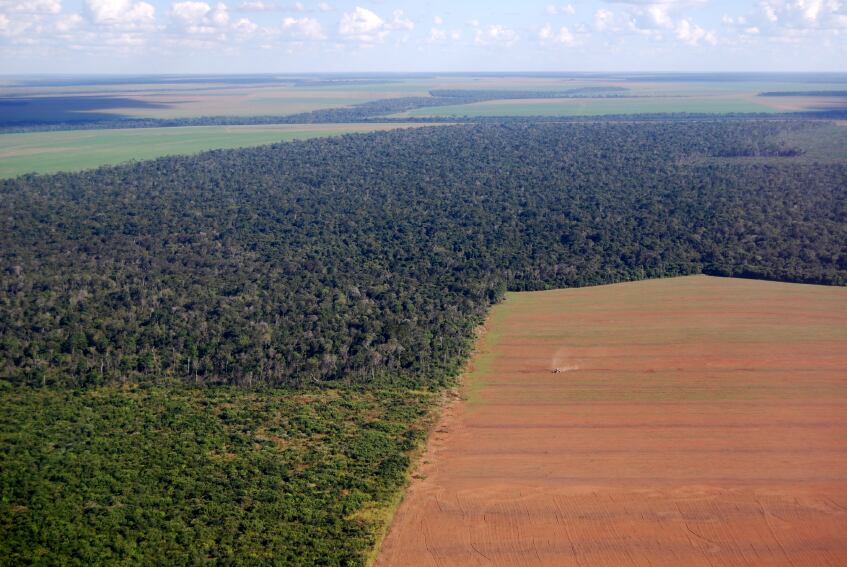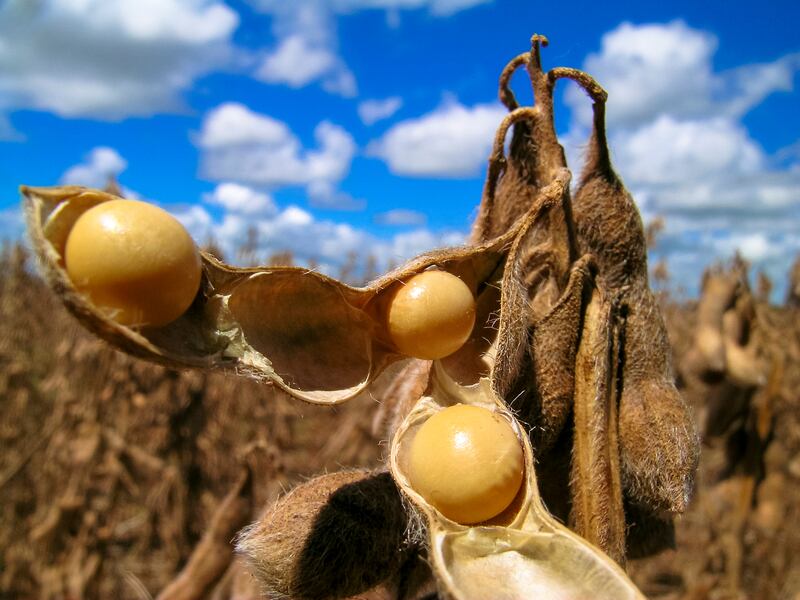If 2018 was the year that problems with palm oil (finally) boiled over, this year’s commodity under attack promises to be soy. As Jun Lyu, chairman of COFCO Corporation, China’s largest food processor, put it in an article published during the Davos World Economic Forum this month, “this small bean has been heavily criticised for its part in deforestation and the associated impact on indigenous communities”.
Most of the attention has been on the Amazon, but as pressure there has eased, production has shifted to places like the Brazilian Cerrado, which covers two million square kilometres and is home to 5% of the world’s biodiversity. Or perhaps was. “We have no way of knowing how many endemic plant species have disappeared so we can grow soy,” noted WWF food systems expert Duncan Williamson, in his contribution to the book Farming, Food and Nature – respecting animals, people and the environment.
What’s been bad news for the environment has been good news for the economy, though. Brazil’s agriculture sector grew a “sizzling” 13% in 2017, noted Reuters recently, while the overall economy barely budged. “The nation's ability to keep producing new farmland cheaply has given it an edge over rivals and cemented its status as a vital supplier to the world's tables.”
Europe has been a particularly good customer, until recently – the tariff war between China and the US (major buyer and supplier of soy respectively) has resulted in large quantities of Brazil’s crop that was destined for Europe now ending up in China. The US has stepped into the void: its share of soybean imports to Europe has jumped from 39% to 75% in a year, according to the latest EU data.

Reputational risks
The world’s demand for soy shows little sign of slowing. Global production of the commodity is around 370 million tonnes currently (up from 270 million in 2012 and 130 million in 1996). The Food and Agriculture Organisation of the United Nations (FAO) reckons it could hit 515 million tonnes by 2050. Leading the charge to meet demand will be Brazil, but the devastation is spreading to neighbouring Argentina too. And for European food manufacturers – whether they use soy directly in their products or indirectly through livestock feed – this poses potentially severe reputational risks within their supply chains.
“There is no legal requirement that the companies document the geographic origin of the soy or provide evidence that it has been produced legally,” noted the campaign group Mighty Earth recently. “As such, it is currently impossible for European companies that source from these traders to ensure that the soy they are buying has not been produced through deforestation.” Traders like Cargill and Bunge, for instance, display “intentional ignorance” about purchasing deforestation-linked soy from parts of Argentina and Paraguay’s Gran Chaco – allegations the companies denied in statements and comments made to our sister site FeedNavigator last year.
Deforestation, as the traders argued, is complex, requiring government, industry, farmers, local communities and civil society to develop new systems. This is true. However, the harder it becomes to track whether the ingredients they are using comes from deforested land, the harder that food brands will look for other solutions. In the UK, food companies including Cranswick, Kerry Foods and Moy Park, plus many of the major supermarkets, have formed a Roundtable on Sustainable Soy. Each brand has committed to publish “timebound plans” by April this year that will ensure the only soy in their supply chains is “legal and cultivated in a way that protects against conversion of forests and valuable native vegetation”.
Struggles with sustainable soy

The roundtable came about because brands were struggling to make headway on commitments such as the Consumer Goods Forum’s zero net deforestation commitment for 2020. On beef, palm oil and timber, many of the leading brands had “clear trajectories” but for soy things were “not so clear”, explained Jonathan Gorman, technical director at Efeca, the consultancy coordinating the UK roundtable. “There was a feeling that [as the CGF target loomed] we needed to pick up the pace,” he told FoodNavigator. Soy’s “higher profile” on the back of its links to environmental degradation was also a consideration, he added.
The intention is to provide a “strong market signal” for sustainable soy, because that’s what a farmer sitting in Brazil wondering what to plant wants to hear. Certification will be part of the solution of course, with some retailers already making commitments to source soy certified by the Roundtable on Responsible Soy (not to be confused with the UK’s roundtable, which isn’t a certification scheme). However, those in the animal feed sector (well over 90% of the soy imported into Europe is used to feed livestock) wonder if the big food companies will put their money where their mouths are. The premium on responsible soy is less than 1%, but this is a supply chain where margins wafer-thin.
Their caution is understandable given what happened with genetically modified soy. Around five years ago, many retailers came out with policies to only use non-GM feed in their supply chains – these were well-publicised at first but were quickly hushed as companies discovered how difficult it is to source GM-free soy. As James McCulloch, head of sector animal feed at the Agricultural Industries Confederation (AIC), put it: there has since been “a change of focus” away from GM and towards sustainability.
In Europe, pressure is also growing on the European Commission to come up with a long-awaited action plan on deforestation – a communication will reportedly be published in the next couple of months. This is welcome. However, for some companies the risks of sourcing from Latin America remain too high – so they are sourcing from Europe instead. UK retailer Waitrose was the first to introduce responsibly sourced non-GM soy animal feed from Europe (for its pigs). Meanwhile, Alpro has quietly increased the proportion of European soy used in its products to 60%. “[By doing that] we shorten the supply chain and limit the transport footprint,” explained Greet Vanderhayden, sustainability manager at Alpro. “We also secure availability of non-GM soy.”
Indeed, currently there isn’t much European soy to go around, but plantations are mushrooming.
Late last year, the European Commission announced plans to expand domestic production of plant proteins, including soy, in order to meet demand. The fact Europe is only 5% self-sufficient in a commodity that underpins its livestock industry and is increasingly important as diets shift towards more flexitarian eating, is a concern. Production is currently up to 2.8 million tonnes, with Germany and France going from very little to 100,000 and 250,000 acres in just five years. In the UK there were a further 8,000 acres last year, according to David McNaughton, director at UK-Soya. “Things are taking off nicely,” he told Foodnavigator. “Surely it makes sense for us to become less reliant on imports and to grow more [of our own] protein.”
FoodNavigator will be publishing a case study detailing Alpro's soy sourcing strategy in Friday's Editor's Spotlight.

